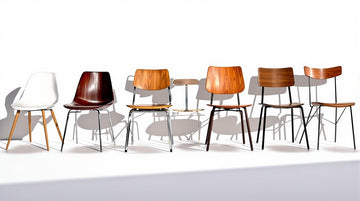The way dining chairs changed over time shows us how home life and what people value have shifted through the years. We can see this change from the basic, practical chairs after World War II to the daring space-inspired designs of the 1960s. Each time period brought its own special touch to how we sit when we eat together. These changes in chair design weren't just about looks - they also came from new ways to make things and new materials that became available. By looking at how dining chairs changed, we can better understand how people thought about both style and usefulness in their homes.
Key Takeaways
Post-war dining chairs embraced minimalism with bent plywood and steel, shifting away from ornate pre-war designs for mass production.
Mid-century modern brought organic curves and warm woods, exemplified by Eames designs that balanced aesthetics with functionality.
Space Age influences introduced molded plastics and vibrant colors, creating futuristic one-piece chairs during the 1960s.
1970s Nordic influences emphasized clean lines and natural materials, featuring floating seats and hidden joints in dining chairs.
Contemporary designs blend classic silhouettes with sustainable materials and ergonomic features for modern environmental consciousness.
Mid-Century Modern Revolution
In the years after World War II, mid-century modern dining chairs changed how furniture was made by blending good looks with usefulness.
Designers began using new materials like bent wood, glass-based materials, and shaped metal to make chairs that showed the hopeful spirit and new technology of the time.
The famous chairs made by Charles and Ray Eames became perfect examples of this style. They found new ways to make many chairs quickly while keeping them beautiful. Their metal dining chairs and wire-base chairs had natural shapes that fit the body well while staying strong.
These chairs got rid of fancy details and focused on simple shapes and comfort.
Designers from Northern Europe also helped shape these modern chairs, adding warm wood and soft curves to balance out the industrial look.
People like Hans Wegner and Arne Jacobsen made chairs that showed skilled craftsmanship while using modern building methods.
Because these chairs were made for regular people to buy, many middle-class homes could now have well-designed furniture.
This way of making furniture still affects how chairs are designed today. For inspiration on incorporating classic pieces, explore vintage lounge furniture styles.
Post-War Design Shift
After World War II, dining chair design changed greatly, moving away from fancy pre-war looks toward simple, useful designs. The use of wartime materials like bent plywood, fiberglass, and steel tubes brought a new style to furniture making.
These changes matched how society was changing, as factories could now make large amounts of furniture for the many new suburban homes being built. People needed chairs that worked well and didn't cost too much. Designers Charles and Ray Eames created new ways to make chairs that could be copied easily while still looking good.
Their famous plastic chair, made from one piece with different bases to choose from, showed exactly what post-war design was about. Materials that were once only used in factories started showing up in home furniture.
Shiny steel, bent wood, and man-made fabrics became common in dining rooms across America and Europe. People also started buying chairs that could stack on top of each other, which was perfect for smaller homes built after the war.
This mix of usefulness and good looks set new standards for furniture design that would last for many years. To explore options for creating diverse looks, check out mixing dining chair styles.
Space Age Materials
The 1960s Space Race changed how dining chairs were made, bringing in new materials like plastics and man-made compounds that were first used in spacecraft.
These new materials let companies make chairs that looked like they came from the future, matching the hopeful outlook of the times. Designers Verner Panton and Eero Aarnio led the way in using shaped plastics to make chairs with smooth, flowing shapes that couldn't be made with old materials.
The main new chair materials from the space age included:
Heated and shaped polypropylene plastic, which made it easy to mass-produce strong, light chairs
Plastic mixed with glass fibers, which could be shaped into curved and hanging designs
Shiny ABS plastic that looked like the smooth outer skin of spaceships
These materials changed both how chairs were made and what they could look like. Makers could now create chairs in bright colors and round shapes that showed how people were excited about space travel and new technology.
Chairs made from one piece of shaped plastic became very popular, giving people easy-to-clean furniture that was both cheap and modern, using the latest advances in materials.
Minimalist Movements
As fancy Space Age designs faded away, simple dining chair styles took over in the late 1960s and grew popular through the 1970s. This change matched wider social moves toward basic looks and useful design.
Taking ideas from Nordic countries, designers began removing extra decoration to create clean, basic shapes. The simple style followed the "less is more" idea started by Ludwig Mies van der Rohe, creating dining chairs with pure shapes and honest materials.
Nordic design showed strongly in the use of light woods like beech and ash, paired with smooth, flowing lines. Important designers like Verner Panton and Arne Jacobsen made chairs that were both plain and comfortable.
The main features of this time were seats that seemed to float, hidden joints, and single-color designs. Designers picked materials for their natural beauty instead of how decorated they could be, making wood patterns and fabric weaves the main focus.
This simple approach changed home dining rooms, turning them into spaces of quiet beauty that still shape furniture design today. For maintenance guidance on upholstered pieces, read about caring for upholstered dining chairs.
Contemporary Design Revivals
In the early 2000s, furniture makers started giving old dining chair designs a fresh look, mixing past styles with new building methods. They used earth-friendly materials and comfort-focused features while keeping the chairs beautiful, which led to new designs that respected old-world skills.
New takes on famous chairs showed these key features:
Use of recycled plastics and certified wood in familiar shapes
Better body support based on 1950s designs
Parts that could be changed out for easy fixes and personal taste
This trend grew as designers worked to meet modern needs while keeping important design history alive.
Some good examples were updates to Eames chairs using plant-based materials and Wegner chairs made from fast-growing bamboo. These new versions kept the feel of the original chairs while adding better back support and weight balance.
Makers used both computer-guided tools and hand-building skills to create chairs that were both green and comfortable.
This mix of old and new ways created dining chairs that honored design history while pushing forward with better materials and user comfort. For insights on environmentally conscious choices, explore sustainable dining furniture options.
Conclusion
The journey of dining chair design mirrors our changing society, from Mid-Century Modern's bold looks to Space Age's use of new materials. At Timbur, we understand how each time period added its own special touch - from practical post-war designs to clean, simple styles and today's eco-friendly choices. As modern craftsmen, we take lessons from these past designs while using new methods and earth-friendly materials, showing how dining tables continue to tell the story of our changing tastes and growing skills.









